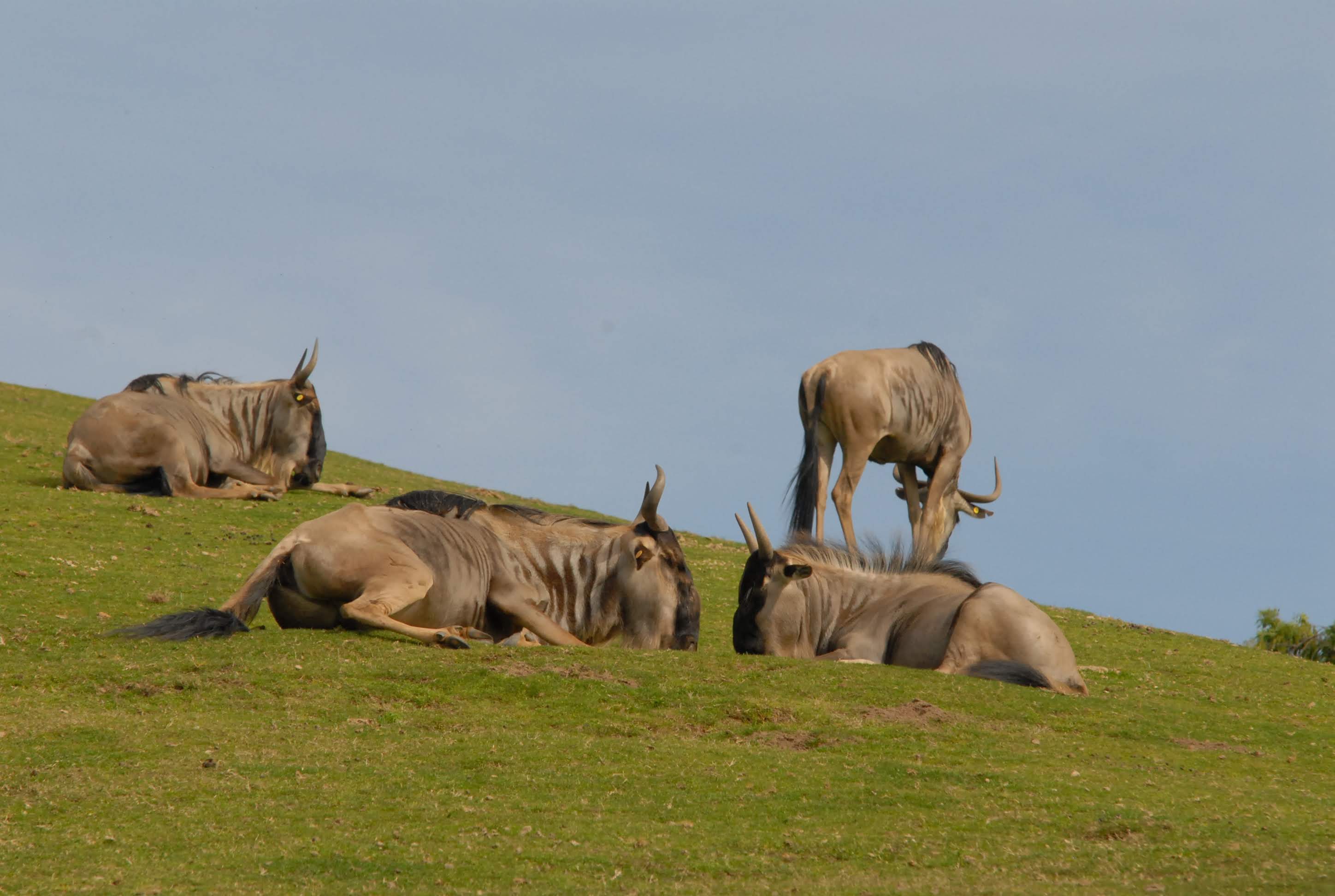I’m about to be licked by a giraffe. It sounds silly but it’s happening. She leans forward to get closer to me, her massive head moving to within a few centimeters of my face. I can feel her heavy breath on my cheek as she extends her enormous 45-cm (18 in) long tongue straight at me. I cringe and smile in delight at the same time. The anticipation is too much and, against every impulse, I shut my eyes. Wow, is this really happening?!
Where am I and how did I get here? I’m standing on the back of a truck on a safari tour. Not in Kenya but in Escondido, California. More specifically, it’s the caravan safari at the San Diego Zoo Safari Park. This special, two-hour guided tour on the back of an open-air truck takes us through a massive, 1,800-acre wildlife conservation park. The Africa enclosure features hundreds of wild African animals living in a natural environment. Giraffe, rhinos, gazelle, buffalos and many other types of sub-Saharan animals intermingle freely and browse the day away in the warm California sunshine. Occasional safari trucks bring visitors on close encounters, where hand-feeding giraffes and rhinos is definitely a favorite activity.
Guided by veteran animal keepers, the safari tour is a mix of fun, education, and conservation. The Safari Park, part of the San Diego Zoo Global, is dedicated to worldwide animal conservation. It is most famed for saving the California Condor from the brink of extinction in the 1980s. But that is only one win in a long history of conservation successes. Today, it’s working to save over 100 species with 400+ partners in more than 40 countries.
The facilities at the Safari Park are second to none. It has bred 97 endangered rhinos to date here alone. “We actively collaborate on species survival plans with zoos around the world,” says our guide. “We determine where we send every rhino we breed before they are even born. It’s important that we closely track the genetic history and ensure the right animals go the right location.”
The park is a non-profit foundation, and revenue is carefully allocated to a mix of on-going operations and conservation projects. “You can imagine, we spend a lot of money on food and care for the animals. That’s why we also offer fun activities for visitors to help fund conservation projects. Two-thirds of the money from the zip line adventure, for example, goes towards condor conservation.” The caravan tour, on the other hand, funds giraffe protection projects in Kenya.

We’ve spent the first 20 minutes of our tour feeding eucalyptus leaves to the giraffes. Some of the animals are greedier than others and keepers make sure that every animal gets their fair share. I’ve seen these “towers of the savannah” through my journeys in southern Africa, but never in my life would I have imagined I would come this close to one, much less get to hand feed them. Touching them is a strict no-no, but I must admit, it takes every bit of restraint in me not to reach out and stroke their beautiful faces. The long and fuzzy snout, the kind and almost-compassionate look, the giant teddy-bear eyes with extra-long eyelashes – this gentle animal is straight out of a storybook. “I just want to hug them” is the universal consensus from everyone on the truck. In the absence of hugging one, I’ll gladly take a giraffe-licking!

We slowly make our way down the rolling hills. Cape buffalo and warthogs casually sunbathe while wildebeest stroll carefree around our truck, though the rhinos completely ignore us today. To mimic the African plains even more closely, a separate enclosure of cheetahs is located nearby, allowing predator and prey to constantly eye each other. The routine flicker of the springbok’s tail is a sign that they are keenly aware of the presence of the cheetahs. And always vigilant.
Eventually, we move on to the Asia enclosure. As we pass through the gates separating Africa and Asia, we are greeted by an intimidating sight – the Indian blackbuck antelope. This huge bovine lives in teak forests of the Indian subcontinent. It may be difficult to believe, but it uses its gigantic horns to attack and sometimes even kill tigers. “This animal does not hide from tigers, it scares them off,” we are told by our guide.
As if hand feeding giraffes wasn’t exciting enough, a thick-plated Asian rhino approaches our truck. She is all too familiar with the bucketloads of apples usually handed out by the humans. As she arrives, her mouth opens up and I can stare straight down her huge oral cavity and throat. It’s enormous! I could practically fit my entire arm in there. She flares her triangular upper lip in eager anticipation of the fruit she is about to get and I toss in half an apple, which she happily devours. More, please, she seems to say, as she holds her head up and continues to flare her lips.
 My favorite fact about these loveable Asian pachyderms? In the wild, they eat mango fruit whole and thereby disperse the seeds throughout the forest. They practically poop mango trees, we joke with each other. The feeding episode lasts about 15 minutes and we all pose for selfies while we feed her off the back of the truck. She even allows us to rub her hard and rough horn. What a fun experience.
My favorite fact about these loveable Asian pachyderms? In the wild, they eat mango fruit whole and thereby disperse the seeds throughout the forest. They practically poop mango trees, we joke with each other. The feeding episode lasts about 15 minutes and we all pose for selfies while we feed her off the back of the truck. She even allows us to rub her hard and rough horn. What a fun experience.
Overall, the Safari Park manages thousands of animals and is also world-renown for its extensive flora collection, numbering over 3,500 unique types of plants. As we step off the tour, our guide advises us that the cheetah is about to make her daily run. We quickly make our way over to the course, eager not to miss this explosive burst of speed from the fastest land animal in the world. I’ve seen this run many times and it never ceases to awe me. I get into prime viewing position only to watch her blow right past me in a blur of yellow and black. Today, we are treated to a delight – she is in a good mood and decides to run a second time for us. A good day for animal lovers!
If you find yourself in southern California, be sure to make your way to the San Diego Zoo Safari Park in Escondido for this special tour and see if you can get licked by a giraffe also.
A special thanks to the staff and guides at the San Diego Zoo Safair Park for making this amazing visit possible.
















Leave a Reply